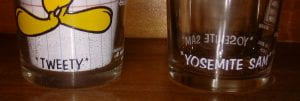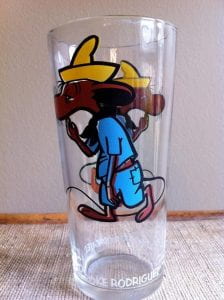Besides the tall drinking glasses that we’re used to seeing, there is another type that we’ll come across. Many jelly companies have released sets of jars to be collectible cups after their use. However, saying that they are ‘collector’s items’ might be wrong. The fact that there was jelly in them is what led it to be a problem. Continue reading
Tag Archives: buying
Are you Up for the Challenge?
As if glass collecting wasn’t hard enough, the greatest challenge still lies ahead. It seems like every set has one. That glass that’s more valuable than the rest, that one that we all need to finally complete our collection, that one . . . that’s the hardest to find. That’s right. There’s always that one that’s so elusive no one can seem to find it no matter how hard we look. The one that makes us question if it even exists. The answer is yes, it does exist. And there lies the rub. Continue reading
Does Size Really Matter?
Sometimes glasses of the same series will come in different sizes (another series within a series). I have seen some that are sixteen-ounce and others that are twelve-ounce. Once again, this complicates matters for up-and-coming collectors. When buying different sizes, would that give a person the impression that their collection is finished? Or would they feel that they now own two incomplete sets of glassware? Continue reading
What’s in a Name?
Apart from the different glass series, there can be a series within a series all due to the colors of the names of each character. As an example, the 1973 Looney Tunes glasses I’m collecting can have the character’s names in either black or white paint. The problem is that there are two different glasses of the same character, all thanks to the different name colors. So, we’re all asking, “Why is this bad?” Well, here’s why.
Game, Set, Match
Another issue is finding and completing a series. A new collector may think that as long as they obtain all the characters then that’s fine. That is sadly not the case. Not only is a set limited by the characters, but they’re also limited by the years they were made. Some franchises, like Disney and Looney Tunes, could have multiple sets featuring the same characters but produced in different years. Continue reading
It’s Just a Pigment of Your Imagination

These two Alvin glasses are in my collection. Notice the fading on the right glass. The only reason I have it is because it was sold along with the good Alvin for a great price.
There is another problem with paint in glassware that needed to be discussed separately from the other issues. It may also be faded, which could be through use and washing or standing in direct sunlight too long. This also decreases a glass’s value. It doesn’t mean you can’t buy it, but it would be subpar compared to the rest of your collection, and it wouldn’t improve the collection either.
A Picture’s Worth a Thousand Words
This post addresses the problems that occur while the paint is being applied to collectible glassware (not to be confused with errors). This specifically decreases the value of glasses. It includes the character’s colors being moved outside of the black outline, splotches of paint covering a character, or grainy texture to the paint. This is frustrating when finding a glass that you haven’t seen before. It could look flawless: vibrant, inside the lines, no discoloring. But after turning it to the other side, the character is wiped out with bumpy white paint. One example would be the Slow Poke Rodriguez glass to the right that has coloring printed outside of the outlines.
To Error is Human…
Another problem that arises in collecting glasses will be types of glasses that are called errors. This term means that something went wrong when creating the glass. It could be that the wrong name was given to a character, a name was cut in half, or other various design flaws such as wrong coloring or forgotten color, smaller nose, etc. If you know your aspiring collection well enough, then you would be able to spot them. The problem occurs when deciding on whether to buy it or not.
A Chip (or Crack) off the Ol’ Glass
When out on glass collecting expeditions and come across some that will display another concerning problem. Most of them were probably used before we find them. Throughout their use, they could have developed chips or cracks in them. Even if the previous owner took good care of them, they could still end up in this condition. These are considered defects and lower the value of the glass.
Logo Under Name

From my collection, the right glass has the logo underneath the name, where the left glass has the logo on the bottom sides (not seen from the front).
Another problem with glass collecting is that there can be multiple versions of a certain glass. One is the Logo Under Name variant, commonly called L.U.N. glasses. It is self-descriptive; whichever company is sponsoring the glasses could have its logo under a character’s name. As an example, the Pepsi logo could appear under the character’s name rather than off to the side, which is the normal version.
Brockway and Federal Thins

These two are from my own collection. Brockway is on the left, and Federal Thin is on the right; notice the difference that the Brockway is slightly wider at the top.
When beginning the hunt, there will be noticeable, physical differences in the types of glasses. I don’t mean the different designs; some will be thicker and heavier than the other thinner, lightweight ones. That’s because there were two different companies that made them. The Brockway Glass Company made their drinking glasses with more glass and wider at the top, making them heavier; while the Federal Glass Company made theirs thinner and more uniform in shape, thus being light-weight. The two types of glasses earned the nicknames of Brockway and Federal Thins respectively. These two types out there are a problem all on their own.
To Buy or Not to Buy
I once said that we could use a trusted site like eBay to buy glasses, but also stated that some people could not be trusted and are just looking for profits. The problem here is that both statements are correct. There is always good alongside the bad, and we all know how true that is. Let’s say, after buying a glass and it was delivered broken. We can contact the seller and they could refund us. They may also ignore the request, where we then would send in a report and is usually solved by the website manager. The problem is like the two sides of a coin, either side could come up when its flipped.
The Importance of Research
Doing research on glasses to buy is an important step for every beginning collector. It will enlighten beginners on the different makes of glass, their values, their rarity, the set it belongs to, and a whole lot more. When beginning, start with the Internet. It is the best tool for the job. Or is it? There are many websites on the World Wide Web to read from, but how can we tell if the information provided is trustworthy at first glance?
Hide and Seek
When deciding on what glasses to collect, just get out there and start looking. But, where does one find them? There are many options: flea markets, auctions, antique shops, online markets, and private individuals. That may have answered the question of where to look, but what problems can occur when visiting these places?



